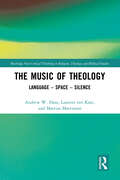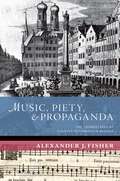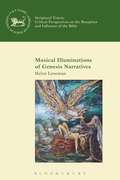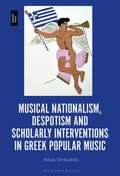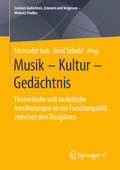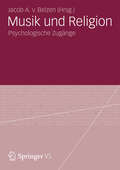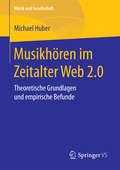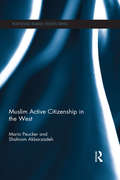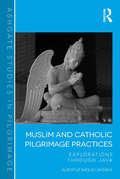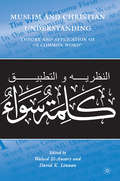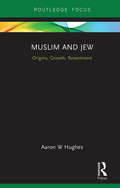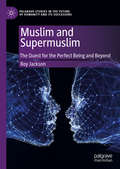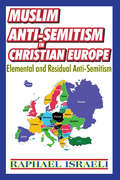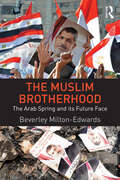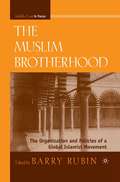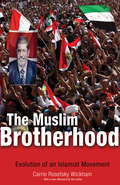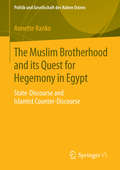- Table View
- List View
The Music of Theology: Language – Space – Silence (Routledge New Critical Thinking in Religion, Theology and Biblical Studies)
by Andrew Hass Mattias Martinson Laurens ten KateThis book reconceives theology as a musical endeavour in critical tension with language, space and silence. An Overture first moves us from music to religion, and then from theology back to music – a circularity that, drawing upon history, sociology, phenomenology, and philosophy, disclaims any theology of music and instead pursues the music in theology. The chapters that follow explore the three central themes by way of theory, music and myth: Adorno, Benjamin and Deleuze (language), Derrida, Rosa and Nancy (space), Schelling/Hegel, Homer and Cage (silence). In overdubbing each other, these chapters work towards theology as a sonorous rhythm between loss and freedom. A Coda provides three brief musical examples – Thomas Tallis, György Ligeti, and Evan Parker – as manifestations of this rhythm, to show in summary how music becomes the very pulse of theology, and theology the very intuition of music. The authors offer an interdisciplinary engagement addressing fundamental questions of the self and the other, of humanity and the divine, in a deconstruction of modern culture and of its bias towards the eye over the ear. The book harmonizes three scholarly voices who attempt to find where the resonance of our Western conceptions and practice, musically and theologically, might resound anew as a more expansive music of theology.
The Music of Theology: Language – Space – Silence (Routledge New Critical Thinking in Religion, Theology and Biblical Studies)
by Andrew Hass Mattias Martinson Laurens ten KateThis book reconceives theology as a musical endeavour in critical tension with language, space and silence. An Overture first moves us from music to religion, and then from theology back to music – a circularity that, drawing upon history, sociology, phenomenology, and philosophy, disclaims any theology of music and instead pursues the music in theology. The chapters that follow explore the three central themes by way of theory, music and myth: Adorno, Benjamin and Deleuze (language), Derrida, Rosa and Nancy (space), Schelling/Hegel, Homer and Cage (silence). In overdubbing each other, these chapters work towards theology as a sonorous rhythm between loss and freedom. A Coda provides three brief musical examples – Thomas Tallis, György Ligeti, and Evan Parker – as manifestations of this rhythm, to show in summary how music becomes the very pulse of theology, and theology the very intuition of music. The authors offer an interdisciplinary engagement addressing fundamental questions of the self and the other, of humanity and the divine, in a deconstruction of modern culture and of its bias towards the eye over the ear. The book harmonizes three scholarly voices who attempt to find where the resonance of our Western conceptions and practice, musically and theologically, might resound anew as a more expansive music of theology.
Music, Piety, and Propaganda: The Soundscapes of Counter-Reformation Bavaria (New Cultural History of Music)
by Alexander J. FisherMusic, Piety, and Propaganda: The Soundscapes of Counter-Reformation Bavaria explores the nature of sound as a powerful yet ambivalent force in the religious struggles that permeated Germany during the Counter-Reformation. Author Alexander J. Fisher goes beyond a musicological treatment of composers, styles, and genres to examine how music, and more broadly sound itself, shaped the aural landscape of Bavaria as the duchy emerged as a militant Catholic bulwark. Fisher focuses particularly on the ways in which sound--including bell-ringing, gunfire, and popular song, as well as cultivated polyphony--not only was deployed by Catholic secular and clerical elites to shape the religious identities of Bavarian subjects, but also carried the potential to challenge and undermine confessional boundaries. Surviving literature, archival documents, and music illustrate the ways in which Bavarian authorities and their allies in the Catholic clergy and orders deployed sound to underline crucial theological differences with their Protestant antagonists, notably the cults of the Virgin Mary, the Eucharist, and the saints. Official and popular rituals like divine worship, processions, and pilgrimages all featured distinctive sounds and music that shaped and reflected an emerging Catholic identity. Although officials imposed a severe regime of religious surveillance, the Catholic state's dominance of the soundscape was hardly assured. Fisher traces archival sources that show the resilience of Protestant vernacular song in Bavaria, the dissemination and performance of forbidden, anti-Catholic songs, the presence of Lutheran chorales in nominally Catholic church services into the late 16th century, and the persistence of popular "noise" more generally. Music, Piety, and Propaganda thus reveals historical, theological, and cultural issues of the period through the piercing dimension of its sounds, bringing into focus the import of sound as a strategic cultural tool with significant impact on the flow of history.
Musical Illuminations of Genesis Narratives (The Library of Hebrew Bible/Old Testament Studies)
by Helen LenemanThis volume examines the stories of Genesis in music, showing how musical settings can illuminate many of the Bible's most noted tales. Helen Leneman studies oratorios, operas and songs (as well as their librettos) to shed light on how Genesis has been understood and experienced over time. Examining an extensive range of musical settings of stories from the book of Genesis, Leneman offers an overview of chiefly 19th and 20th century musical engagements with this biblical text.Leneman first discusses how Eve's inner thoughts are explored by noted French composers Jules Massenet and Gabriel Fauré. The text then enters the deep waters of Noah's flood in examination of several compositions, including two unusual settings by Igor Stravinsky and Benjamin Britten, as well as more conventional settings by Saint-Saëns and Donizetti. Two major 19th century oratorio settings of Abraham's story by lesserknown German composers Martin Blumner and Karl Mangold provide fascinating illuminations of the Abraham narratives, whereas parts of Rebecca's story are found in works by César Franck, Ferdinand Hiller, and most unusually, by a French woman composer, Célanie Carissan. Finally, Leneman shows how Joseph's story was set in numerous oratorios (including by Handel) but that one of the most important works based on his story is an opera by 18th century French composer Etienne Méhul. In addition to discussing these larger 19th century works, Leneman also examines several interesting atonal 20th century works based on the stories of Eve and the Flood, shedding new light on the history of the interpretation of the Book of Genesis.
Musical Nationalism, Despotism and Scholarly Interventions in Greek Popular Music
by Nikos OrdoulidisThis book discusses the relationship between Greek Orthodox ecclesiastical music and laiko (popular) song in Greece. Laiko music was long considered a lesser form of music in Greece, with rural folk music considered serious enough to carry the weight of the ideologies founded within the establishment of the contemporary Greek state. During the 1940s and 1950s, a selective exoneration of urban popular music took place, one of its most popular cases being the originating relationships between two extremely popular musical pieces: Vasilis Tsitsanis's “Synnefiasmeni Kyriaki” (Cloudy Sunday) and its descent from the hymn “Ti Ypermacho” (The Akathist Hymn). During this period the connection of these two pieces was forged in the Modern Greek conscience, led by certain key figures in the authority system of the scholarly world. Through analysis of these pieces and the surrounding contexts, Ordoulidis explores the changing role and perception of popular music in Greece.
Musical Nationalism, Despotism and Scholarly Interventions in Greek Popular Music
by Nikos OrdoulidisThis book discusses the relationship between Greek Orthodox ecclesiastical music and laiko (popular) song in Greece. Laiko music was long considered a lesser form of music in Greece, with rural folk music considered serious enough to carry the weight of the ideologies founded within the establishment of the contemporary Greek state. During the 1940s and 1950s, a selective exoneration of urban popular music took place, one of its most popular cases being the originating relationships between two extremely popular musical pieces: Vasilis Tsitsanis's “Synnefiasmeni Kyriaki” (Cloudy Sunday) and its descent from the hymn “Ti Ypermacho” (The Akathist Hymn). During this period the connection of these two pieces was forged in the Modern Greek conscience, led by certain key figures in the authority system of the scholarly world. Through analysis of these pieces and the surrounding contexts, Ordoulidis explores the changing role and perception of popular music in Greece.
Musik – Kultur – Gedächtnis: Theoretische und analytische Annäherungen an ein Forschungsfeld zwischen den Disziplinen (Soziales Gedächtnis, Erinnern und Vergessen – Memory Studies)
Der Band untersucht das durch die Begriffe Musik, Kultur und Gedächtnis abgesteckte Feld in einer zweifachen Bewegung: Zum einen wird Musik als eine wichtige soziokulturelle Ausdrucksform quer durch alle Kulturen gefasst, ihre Bestimmung und Funktion ändern sich mit den jeweiligen soziokulturellen Kontexten und Praxen. Jedes Musikstück steht in spezifischen kulturell entwickelten Traditionen und Formen, die von ihm aktualisiert werden. Musik wirkt als »gemeinschaftsbildende Macht« (Adorno), als Ausdrucksmittel individueller oder kollektiver Identität. Zum anderen ist den vielfältigen Formen von Musik die mehrfache Verbindung von Musik und Zeit gemeinsam: Die jeweilige musikalische Darbietung oder Reproduktion ist ein zeitlicher Ablauf und als solcher gedächtnishaft organisiert. Die ästhetische Erfahrung von Musik ist konstitutiv auf Gedächtnisleistungen angewiesen und Musik selbst eine temporale Kunstform. Neben dieser elementaren Zeitlichkeit zeigen sich in der Musik aber viele weitere Aspekte subjektiver und sozialer Zeit: die Geschichtlichkeit der einzelnen Stücke bzw. Werke selbst, die soziokulturelle zeitliche Lagerung von Ordnungsprinzipien wie Gattungen, Kunstformen, Stilen etc., der Wandel von basalen Formen des Musikmachens (etwa unter dem Einfluss von Medientechnologien). Der Band enthält auch die deutsche Erstveröffentlichung eines Artikels von Maurice Halbwachs zu diesem Themenfeld.
Musik und Religion: Psychologische Zugänge
by Jacob A. V. Van BelzenZwischen Musik und Religion gibt es vielerlei Beziehungen: Bekannte religiöse Texte sind unzählige Male vertont worden, religiöse Institutionen haben Kompositionen in Auftrag gegeben, in religiöser Architektur finden Konzerte statt usw. Auch der Psychologie gibt das Thema “religiöse Musik” viele Fragen vor: Warum berührt religiöse Musik Menschen oft eigentümlich, sogar solche, die sich als nicht-religiös empfinden? Sind Religiosität und Musikalität evolutionär-psychologisch analog zu verstehen? Haben Religion und Musik gleiche pränatale Wurzeln? Dienen sie denselben psychologischen Funktionen? Wie ist die manchmal therapeutische Rolle von Musik in religiösen Kontexten zu verstehen? Dies sind nur einige der Fragen, denen sich die AutorInnen in diesem Band widmen. Sie gewähren einen aufschlussreichen Einblick in die Möglichkeiten psychologischer Analyse der Beziehungen zwischen Religion und Musik.
Musikhören im Zeitalter Web 2.0: Theoretische Grundlagen und empirische Befunde (Musik und Gesellschaft)
by Michael HuberIn Anschluss an aktuelle Erkenntnisse soziologischer und sozialpsychologischer Musikrezeptionsforschung erläutert der Band, welche gesellschaftlichen Funktionen das Musikhören heute erfüllt und welche Rolle hier die neuen Rahmenbedingungen im Web 2.0 spielen. Auf Basis repräsentativer empirischer Erhebungen werden musikalische Einstellungen und Verhaltensweisen illustriert sowie klar abgrenzbare Musikhörtypen charakterisiert, die in je besonderer Weise mit den aktuellen Möglichkeiten und Herausforderungen der digitalen Mediamorphose umgehen. Besondere Berücksichtigung findet dabei die Frage nach der Bedeutung primärer Sozialisation als Gegengewicht zur musikalischen Selbstsozialisation im Internet. Vor allem Alter, Schulbildung und Wohnortsgröße der Menschen zeigen sich als entscheidende Einflussgrößen der individuellen musikalischen Praxis in Österreich.
Muslim Active Citizenship in the West (Routledge Islamic Studies Series)
by Mario Peucker Shahram AkbarzadehMuslim Active Citizenship in the West investigates the emergence and nature of Muslims’ struggle for recognition as full members of society in Australia, Great Britain and Germany. What actions have been taken by Muslims to achieve equal civic standing? How do socio-political and socio-economic factors impact on these processes? And how do Muslims negotiate their place in a society that is often regarded as sceptical – if not hostile – towards Muslims’ desire to belong? This book sheds new light on Muslims’ path towards citizenship in Australia, Great Britain and Germany. Existing research and statistics on Muslims’ socio-economic status, community formation, claim-making and political responses, and the public portrayal of Islam are systematically examined. These insights are tested ‘through the eyes of Muslims’, based on in-depth interviews with Muslim community leaders and other experts in all three countries. The findings offer unique perspectives on Muslim resilience to be recognised as equal citizens of Islamic faith in very different socio-political national settings. Pursuing an interdisciplinary and comparative approach, this book examines the country-specific interplay of historical, institutional, political, and identity dimensions of Muslims’ active citizenship and will be invaluable for students and researchers with an interest in Sociology, Religious Studies and Political Science.
Muslim Active Citizenship in the West (Routledge Islamic Studies Series)
by Mario Peucker Shahram AkbarzadehMuslim Active Citizenship in the West investigates the emergence and nature of Muslims’ struggle for recognition as full members of society in Australia, Great Britain and Germany. What actions have been taken by Muslims to achieve equal civic standing? How do socio-political and socio-economic factors impact on these processes? And how do Muslims negotiate their place in a society that is often regarded as sceptical – if not hostile – towards Muslims’ desire to belong? This book sheds new light on Muslims’ path towards citizenship in Australia, Great Britain and Germany. Existing research and statistics on Muslims’ socio-economic status, community formation, claim-making and political responses, and the public portrayal of Islam are systematically examined. These insights are tested ‘through the eyes of Muslims’, based on in-depth interviews with Muslim community leaders and other experts in all three countries. The findings offer unique perspectives on Muslim resilience to be recognised as equal citizens of Islamic faith in very different socio-political national settings. Pursuing an interdisciplinary and comparative approach, this book examines the country-specific interplay of historical, institutional, political, and identity dimensions of Muslims’ active citizenship and will be invaluable for students and researchers with an interest in Sociology, Religious Studies and Political Science.
Muslim and Catholic Pilgrimage Practices: Explorations Through Java (Routledge Studies in Pilgrimage, Religious Travel and Tourism)
by Albertus Bagus LaksanaExploring the distinctive nature and role of local pilgrimage traditions among Muslims and Catholics, Muslim and Catholic Pilgrimage Practices draws particularly on south central Java, Indonesia. In this area, the hybrid local Muslim pilgrimage culture is shaped by traditional Islam, the Javano-Islamic sultanates, and the Javanese culture with its strong Hindu-Buddhist heritage. This region is also home to a vibrant Catholic community whose identity formation has occurred in a way that involves complex engagements with Islam as well as Javanese culture. In this respect, local pilgrimage tradition presents itself as a rich milieu in which these complex engagements have been taking place between Islam, Catholicism, and Javanese culture. Employing a comparative theological and phenomenological analysis, this book reveals the deeper religio-cultural and theological import of pilgrimage practice in the identity formation and interaction among Muslims and Catholics in south central Java. In a wider context, it also sheds light on the larger dynamics of the complex encounter between Islam, Christianity and local cultures.
Muslim and Catholic Pilgrimage Practices: Explorations Through Java (Routledge Studies in Pilgrimage, Religious Travel and Tourism)
by Albertus Bagus LaksanaExploring the distinctive nature and role of local pilgrimage traditions among Muslims and Catholics, Muslim and Catholic Pilgrimage Practices draws particularly on south central Java, Indonesia. In this area, the hybrid local Muslim pilgrimage culture is shaped by traditional Islam, the Javano-Islamic sultanates, and the Javanese culture with its strong Hindu-Buddhist heritage. This region is also home to a vibrant Catholic community whose identity formation has occurred in a way that involves complex engagements with Islam as well as Javanese culture. In this respect, local pilgrimage tradition presents itself as a rich milieu in which these complex engagements have been taking place between Islam, Catholicism, and Javanese culture. Employing a comparative theological and phenomenological analysis, this book reveals the deeper religio-cultural and theological import of pilgrimage practice in the identity formation and interaction among Muslims and Catholics in south central Java. In a wider context, it also sheds light on the larger dynamics of the complex encounter between Islam, Christianity and local cultures.
Muslim and Christian Understanding: Theory and Application of “A Common Word”
by Waleed El-Ansary & David K. LinnanThis book explores 'A Common Word Between Us and You', a high-level ongoing Christian-Muslim dialogue process. The Common Word process was commenced by leading Islamic scholars and intellectuals as outreach in response to the Pope's much criticized Regensburg address of 2007.
Muslim and Jew: Origins, Growth, Resentment (Routledge Focus on Religion)
by Aaron W HughesMuslim and Jew: Origins, Growth, Resentment seeks to show how and why Islam and Judaism have been involved in political and theological self-definitions using the other since the seventh century. This short volume provides a historical and comparative survey of how each religion has thought about the other and, in so doing, about itself. It confines itself to those points at which Judaism and Islam intersect and cross-pollinate, and explores how this delicate process continues into the present with the Israeli–Palestinian conflict. Muslim and Jew thus seeks to move beyond the intersection of a monolithic Judaism and a monolithic Islam and instead examines and organizes the messiness of the encounter as both religions sought to define themselves within, from, and against the other.
Muslim and Jew: Origins, Growth, Resentment (Routledge Focus on Religion)
by Aaron W HughesMuslim and Jew: Origins, Growth, Resentment seeks to show how and why Islam and Judaism have been involved in political and theological self-definitions using the other since the seventh century. This short volume provides a historical and comparative survey of how each religion has thought about the other and, in so doing, about itself. It confines itself to those points at which Judaism and Islam intersect and cross-pollinate, and explores how this delicate process continues into the present with the Israeli–Palestinian conflict. Muslim and Jew thus seeks to move beyond the intersection of a monolithic Judaism and a monolithic Islam and instead examines and organizes the messiness of the encounter as both religions sought to define themselves within, from, and against the other.
Muslim and Supermuslim: The Quest for the Perfect Being and Beyond (Palgrave Studies in the Future of Humanity and its Successors)
by Roy JacksonThis book looks to the rich and varied Islamic tradition for insights into what it means to be human and, by implication, what this can tell us about the future human. The transhumanist movement, in its more radical expression, sees Homo sapiens as the cousin, perhaps the poorer cousin, of a new Humanity 2.0: ‘Man’ is replaced by ‘Superman’. The contribution that Islam can make to this movement concerns the central question of what this ‘Superman’ – or ‘Supermuslim’ – would actually entail. To look at what Islam can contribute we need not restrict ourselves to the Qur’an and the legal tradition, but also reach out to its philosophical and literary corpus. Roy Jackson focuses on such contributions from Muslim philosophy, science, and literature to see how Islam can confront and respond to the challenges raised by the growing movement of transhumanism.
Muslim Anti-Semitism in Christian Europe: Elemental and Residual Anti-Semitism
by Raphael IsraeliModern Arab and Muslim hostility towards Jews and Israel is rooted not only in the Arab-Israeli conflict and traditional Islamic teaching but also in Christian anti-Semitic attitudes brought into the Islamic world by Western colonial powers. In this volume, Raphael Israeli examines how the worsening situation in the Middle East together with large waves of Muslim immigration to Europe, North America, and Australia has brought about a commingling of two anti-Semitic traditions. As the author explains, the unique interaction of Muslim immigrants in the West with the host societies brought them into contact with local, traditional anti-Semites of the xenophobic fascist and racist Right along with the avowedly anti-Zionist Left, to build a formidable wall of hatred against the Jewish state and its people. To complicate this picture further the same Muslim immigrants share with them minority status in a Christian-majority society. Often finding themselves at odds with the majority host society, they find themselves subject to criticism and censure on all sides. They are engaged simultaneously in battle with both their host society into which they cannot integrate, and their Jewish compatriots who are a model of good integration. Consequently, they feel exposed and lose ground in the struggle for social acceptance. Israeli lays out the nature and ideologies of the Muslim immigrant world and shows how in each European country they create their own ethnic sub-groups and religious communities, often in competition with each other. This remarkable and courageous book will be of interest to sociologists, Middle East specialists, and political scientists.
Muslim Anti-Semitism in Christian Europe: Elemental and Residual Anti-Semitism
by Raphael IsraeliModern Arab and Muslim hostility towards Jews and Israel is rooted not only in the Arab-Israeli conflict and traditional Islamic teaching but also in Christian anti-Semitic attitudes brought into the Islamic world by Western colonial powers. In this volume, Raphael Israeli examines how the worsening situation in the Middle East together with large waves of Muslim immigration to Europe, North America, and Australia has brought about a commingling of two anti-Semitic traditions. As the author explains, the unique interaction of Muslim immigrants in the West with the host societies brought them into contact with local, traditional anti-Semites of the xenophobic fascist and racist Right along with the avowedly anti-Zionist Left, to build a formidable wall of hatred against the Jewish state and its people. To complicate this picture further the same Muslim immigrants share with them minority status in a Christian-majority society. Often finding themselves at odds with the majority host society, they find themselves subject to criticism and censure on all sides. They are engaged simultaneously in battle with both their host society into which they cannot integrate, and their Jewish compatriots who are a model of good integration. Consequently, they feel exposed and lose ground in the struggle for social acceptance. Israeli lays out the nature and ideologies of the Muslim immigrant world and shows how in each European country they create their own ethnic sub-groups and religious communities, often in competition with each other. This remarkable and courageous book will be of interest to sociologists, Middle East specialists, and political scientists.
The Muslim Brotherhood: The Arab Spring and its future face
by Beverley Milton-EdwardsThe Muslim Brotherhood is the most significant and enduring Sunni Islamist organization of the contemporary era. Its roots lie in the Middle East but it has grown into both a local and global movement, with its well-placed branches reacting effectively to take the opportunities for power and electoral competition offered by the Arab Spring. Regarded by some as a force of moderation among Islamists, and by others as a façade hiding a terrorist fundamentalist threat, the potential influence of the Muslim Brotherhood on Middle Eastern politics remains ambiguous. The Muslim Brotherhood: The Arab Spring and its Future Face provides an essential insight into the organisation, with chapters devoted to specific cases where the Brotherhood has important impacts on society, the state and politics. Key themes associated with the Brotherhood, such as democracy, equality, pan-Islamism, radicalism, reform, the Palestine issue and gender, are assessed to reveal an evolutionary trend within the movement since its founding in Egypt in 1928 to its manifestation as the largest Sunni Islamist movement in the Middle East in the 21st century. The book addresses the possible future of the Muslim Brotherhood; whether it can surprise sceptics and effectively accommodate democracy and secular trends, and how its ascension to power through the ballot box might influence Western policy debates on their engagement with this manifestation of political Islam. Drawing on a wide range of sources, this book presents a comprehensive study of a newly resurgent movement and is a valuable resource for students, scholars and policy makers focused on Middle Eastern Politics.
The Muslim Brotherhood: The Arab Spring and its future face
by Beverley Milton-EdwardsThe Muslim Brotherhood is the most significant and enduring Sunni Islamist organization of the contemporary era. Its roots lie in the Middle East but it has grown into both a local and global movement, with its well-placed branches reacting effectively to take the opportunities for power and electoral competition offered by the Arab Spring. Regarded by some as a force of moderation among Islamists, and by others as a façade hiding a terrorist fundamentalist threat, the potential influence of the Muslim Brotherhood on Middle Eastern politics remains ambiguous. The Muslim Brotherhood: The Arab Spring and its Future Face provides an essential insight into the organisation, with chapters devoted to specific cases where the Brotherhood has important impacts on society, the state and politics. Key themes associated with the Brotherhood, such as democracy, equality, pan-Islamism, radicalism, reform, the Palestine issue and gender, are assessed to reveal an evolutionary trend within the movement since its founding in Egypt in 1928 to its manifestation as the largest Sunni Islamist movement in the Middle East in the 21st century. The book addresses the possible future of the Muslim Brotherhood; whether it can surprise sceptics and effectively accommodate democracy and secular trends, and how its ascension to power through the ballot box might influence Western policy debates on their engagement with this manifestation of political Islam. Drawing on a wide range of sources, this book presents a comprehensive study of a newly resurgent movement and is a valuable resource for students, scholars and policy makers focused on Middle Eastern Politics.
The Muslim Brotherhood: The Organization and Policies of a Global Islamist Movement (Middle East in Focus)
by B. RubinThe Muslim Brotherhood is the oldest and most important international Islamist group. Aside from strong organizations in Egypt, Jordan, Syria—where it provides the main opposition—and its Palestinian offshoot Hamas which rules the Gaza Strip, the Brotherhood has become active in Europe and North America.
The Muslim Brotherhood: Evolution of an Islamist Movement
by Carrie Rosefsky WickhamFollowing the Arab Spring, the Muslim Brotherhood achieved a level of influence previously unimaginable. Yet the implications of the Brotherhood's rise and dramatic fall for the future of democratic governance, peace, and stability in the region are disputed and remain open to debate. Drawing on more than one hundred in-depth interviews as well as Arabic-language sources never before accessed by Western researchers, Carrie Rosefsky Wickham traces the evolution of the Muslim Brotherhood in Egypt from its founding in 1928 to the fall of Hosni Mubarak and the watershed elections of 2011-2012. Highlighting elements of movement continuity and change, Wickham demonstrates that shifts in Islamist worldviews, goals, and strategies are not the result of a single strand of cause and effect, and provides a systematic, fine-grained account of Islamist group evolution in Egypt and the wider Arab world.In a new afterword, Wickham discusses what has happened in Egypt since Muhammad Morsi was ousted and the Muslim Brotherhood fell from power.
The Muslim Brotherhood: Evolution of an Islamist Movement
by Carrie Rosefsky WickhamFollowing the Arab Spring, the Muslim Brotherhood achieved a level of influence previously unimaginable. Yet the implications of the Brotherhood's rise and dramatic fall for the future of democratic governance, peace, and stability in the region are disputed and remain open to debate. Drawing on more than one hundred in-depth interviews as well as Arabic-language sources never before accessed by Western researchers, Carrie Rosefsky Wickham traces the evolution of the Muslim Brotherhood in Egypt from its founding in 1928 to the fall of Hosni Mubarak and the watershed elections of 2011-2012. Highlighting elements of movement continuity and change, Wickham demonstrates that shifts in Islamist worldviews, goals, and strategies are not the result of a single strand of cause and effect, and provides a systematic, fine-grained account of Islamist group evolution in Egypt and the wider Arab world.In a new afterword, Wickham discusses what has happened in Egypt since Muhammad Morsi was ousted and the Muslim Brotherhood fell from power.
The Muslim Brotherhood and its Quest for Hegemony in Egypt: State-Discourse and Islamist Counter-Discourse (Politik und Gesellschaft des Nahen Ostens)
by Annette RankoAnnette Ranko analyses the Muslim Brotherhood’s challenging of the Mubarak regime and the ensuing struggle between the two from 1981 to 2011. She furthermore traces how the group evolved throughout the process of that struggle. She studies how the Brotherhood’s portrayal of itself as an attractive alternative to the regime provoked the Mubarak regime to level anti-Brotherhood propaganda in the state-run media in order to contain the group’s appeal amongst the public. The author shows how the regime’s portrayal of the Brotherhood and the Brotherhood’s engagement with it have evolved over time, and how this ideational interplay has combined with structural institutional aspects in shaping the group’s behaviour and ideology.
